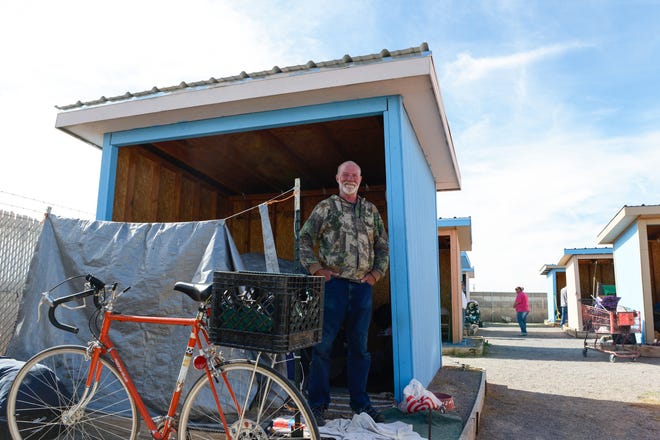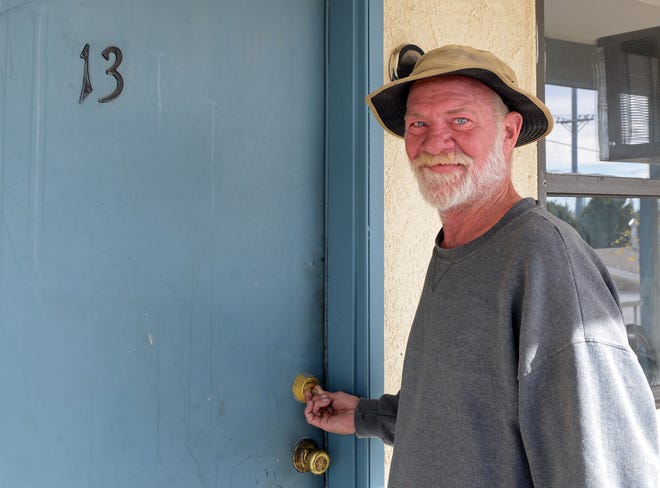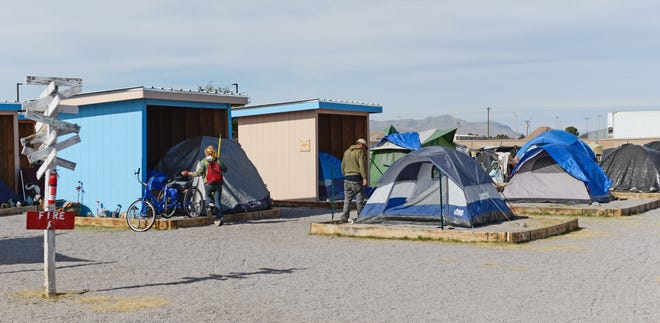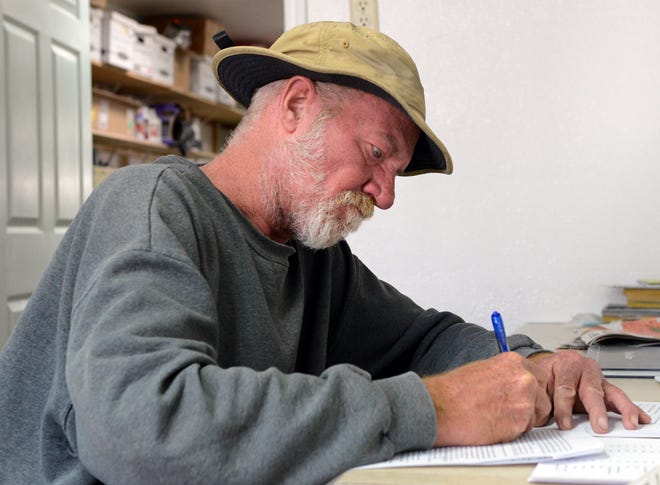Tents to Rents helps Las Cruces homeless move into permanent housing

LAS CRUCES - Even before Alan Abrams unpacked anything at his first permanent home in three years, he was already imagining his first meal.
He planned to walk to Albertsons on El Paseo Road and buy fresh crab legs. He intended to boil them and serve them with a baked potato.
“I’ve been hungry for crab legs for over a year,” he said. “I already made up my mind: That will be tonight’s dinner. It’s going to be my welcome home.”
Abrams last week became the third person to move out of Camp Hope, a government-sanctioned tent city for homeless people at Mesilla Valley Community of Hope, as part of organization’s Tents to Rents program.

Tents to Rents is a fundraising program initiated by Community of Hope in 2016 to pay for food and supplies at Camp Hope, and help homeless people living in the camp to make the transition to permanent housing. It has raised about $90,000 from local businesses and individuals.
Abrams, 56, moved into a one-bedroom apartment on Espina Avenue with the help of Community of Hope staff. They supplied him a mattress and box spring, sheets for his bed, a big screen TV, and a microwave oven.
Community of Hope will pay his rent for up to 24 months, thanks to a grant from the city of Las Cruces. He will get a utility allowance. He gets food stamps. He can get a box a food once a month from Casa de Peregrinos, a food pantry that operates on the Community of Hope campus.
When Abrams moved in, the apartment wasn’t quite ready. The kitchen floor was a mess. The refrigerator still needed to be replaced. A new towel rack was being installed. Maintenance staff were apologetic, but Abrams wasn’t complaining.
“We’ll get it done,” he said. “It looks good. I like it. I like this location. You’ve got El Paseo right there. Two blocks away you’ve got Solano. Albertsons three blocks away. This is ideal.”
Camp Hope
Abrams had been homeless since November 2017, longer if you count two years traveling the country in a camper. He had lived in Camp Hope since June 2018. It was actually his second stint there. He had lived there with his wife for two months last year, but they were kicked out for fighting.
His space at Camp Hope was one of the better sites. Sitting next to a fence topped with barbed wire, he had neighbors on only two sides. His tent, provided by Community of Hope, was semi-protected from the elements by a three-sided wood structure with a roof.
Camp Hope has a capacity for 50 residents. There are 45 tent sites (some are occupied by couples), 15 covered by wood structures. There are currently 36 people living there, 26 males and 10 females. The average stay is about six months. There is no maximum stay.

LAST YEAR:Volunteers give new look to Camp Hope
There is a kitchen for use by campers. It has hot plates and a microwave oven. There are gas grills and a wood-burning horno, where residents can bake pizzas. There are men’s and women’s toilets with showers. Only the bathrooms have heat. The kitchen and guard “shack” have electricity. There are solar-powered lights throughout the camp.
Camp Hope has operated since 2011, when homeless people camping informally in the area but threatened with eviction appealed to the Las Cruces City Council to allow them to establish a tent city on city-owned land adjacent to Community of Hope. The City Council agreed to let them stay for 90 days.
When the end of the 90-day period neared, Nicole Martinez, executive director of Community of Hope, asked the Council to allow the tent city to become permanent. Council agreed so long as the certain conditions were met.
Camp Hope is unusual nationally. A 2017 study conducted by the National Law Center on Homelessness & Poverty found that just 10 of 187 cities surveyed explicitly permitted some form of legalized camping by the homeless. Many cities prohibit such camping and clear encampments that develop.
The report called Camp Hope “a model for providing a low-cost, safe, secure location from which residents can base their transition back to housing at their own pace.”
To live at Camp Hope, homeless people must submit a written application and meet with Community of Hope staff. There are no admission requirements. Only people with open warrants for their arrest and children are prohibited.

Occasionally, people will be rejected, if they have a known history of violent behavior or have caused problems at Community of Hope. But there are no background checks.
“Most people end up getting in,” Martinez said. “Even if we know they have substance abuse or mental health issues, we want to give everyone a chance.”
Residents must abide by 28 rules. Drinking and drugs are prohibited. No threatening or violent behavior is allowed. Smoking in tents is forbidden, as are open fires. Residents must perform six hours of volunteer service per week.
About once a week people are kicked out for various reasons, as Abrams was.
One reason Camp Hope has been a success is because it is self-governed by the people who live there. They help establish rules. They meet once a week to discuss problems and make changes. They staff the guard “shack” 24 hours a day, clean restrooms and process donations.
More:Las Cruces event raises thousands for homeless youth
Compared to informal homeless camps or living on the street, Camp Hope provides a secure place to live, even if residents must give up some of their freedom for the larger good.
“I love Camp Hope,” Abrams said before leaving. “I’m going to miss this place. I have a lot of good friends here. It’s a pretty good group of people. You have occasional verbal arguments, but not very often. It’s a place where you can get off the street, pretty secure and safe, more than enough food.”
Homeless ... by accident
Abrams’ story demonstrates that all it takes is a little bad luck, and perhaps a lack of insurance, to end up homeless.
Born and raised in Normal, Illinois, he’d worked all his adult life since joining the Army six days after graduating from high school. He made good money, raised a daughter by himself, owned a home, did everything right.
After being discharged from the Army, he attended Illinois State University for two years, then jumped around a bit, living in Chicago and St. Louis briefly, before returning to Normal, where he became involved with a woman and they had a child.
Parenthood forced him to settle down. He won custody of his daughter and they moved to Winter Haven, Florida, where his father lived. There he entered an apprenticeship program and became an electrician. He worked as an electrician for the next 17 years.
When his daughter graduated from high school and joined the Army, he moved back to Illinois to help his mother, who had suffered two heart attacks. He worked as a security guard. His mom died about 2014. A year later, he suffered a stroke, which forced him to quit work. The stroke caused nerve damage in his hand and foot, and left one side of his face numb.
Abrams met a woman from Batavia, New York, on an online card-playing site dedicated to the game Euchre. They “hit it off,” he said, and he moved to Batavia. A year later they married.
They were living something of a dream life, but their good fortune ended abruptly. Abrams had inherited $50,000 from his mother, and he used that money to buy a pickup truck and a 30-foot travel trailer.
“Me and my wife just traveled around the U.S. sightseeing,” he said.

A childhood friend of Abrams’ lived in Las Cruces and he invited the couple to visit. They loved it and decided to move to New Mexico.
En route to Las Cruces in November 2017, however, they had a flat tire in Texas, which caused the trailer to jackknife. The force of the accident caused most of the trailer and everything in it to separate from the frame. All their possessions wound up in a ditch.
“We lost everything we owned,” Abrams said. “When we lost our trailer, we lost our home.”
They had no insurance on the trailer and no savings, not enough money for a place to live. On Abrams friend’s suggestion, they moved into Camp Hope.
“We were flat broke,” Abrams said.
Living in a tent in a homeless camp didn’t appeal to Abrams’ wife — “she’s more of a city girl,” he said — and their marriage quickly deteriorated. They fought often and were kicked out of Camp Hope the next month as a result.
Abrams’ wife moved back to New York and took their truck. Carless, Abrams hitchhiked to Dripping Springs Natural Area and camped in the mountains, out of sight of park officials, surviving on “handouts and pawning anything I didn’t need,” he said.
He remained in the mountains for six months until he was able to get back into Camp Hope in June 2018. Contrary to his wife, Abrams liked Camp Hope. He loves the outdoors, and camped and backpacked even before he became homeless.
For Abrams, the two biggest challenges of living in Camp Hope were boredom and the cold. To combat the tedium of life in a tent, he would leave Camp Hope every morning about 8 or 9, ride his bike into town and spend the day at Branigan Library or the Munson Senior Center. He wouldn’t return to the camp until dinnertime.
Nighttime was more difficult, particularly as temperatures turned frigid. Las Cruces may be a warm city, but it gets plenty cold at night this time of year if you’re living outside. He owns a battery-powered DVD player and he would wrap himself in a blanket and watch movies until bedtime.
“The cold right now — it’s cold,” he said. “The morning when you get up, to me, is the worst.”
More:6 ways to help homeless, needy residents in Las Cruces as wintry weather sets in
Warm welcome

The first thing Abrams did when he checked out his new apartment, in fact, was to locate and examine the heater. It is combined with an air conditioning unit installed in the front wall of the living room.
Abrams problems aren’t over. He has no source of income. He’s not sure he can work because of the lingering effects of his stroke. He applied for disability payments but was rejected. He has appealed that decision. His rent is taken care of for two years, but what will happen after that is still to be determined.
Still, he was clearly happy on moving day and smiled often. He hugged a Community of Hope worker who wished him well. He praised Aide Lechuga, the case manager who coordinated his move and made sure he had what he needed in his new home.
When you’ve been homeless, the simplest comforts can seem monumental — a bed, a kitchen, your own bathroom. But what did he like most about his new home?
“Heat,” he said. “Right now, heat! I’m not freezing anymore.”
Blake Gumprecht may be reached at 575-541-5453, bgumprecht@lcsun-news.com or @blakegumprecht on Twitter.